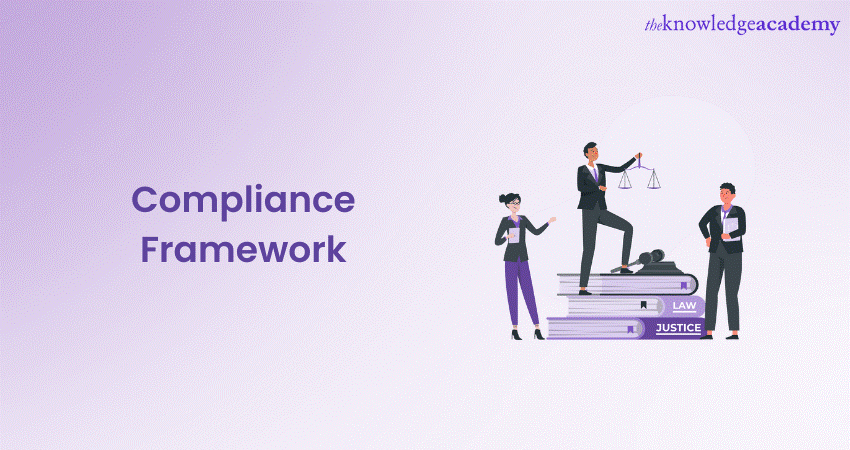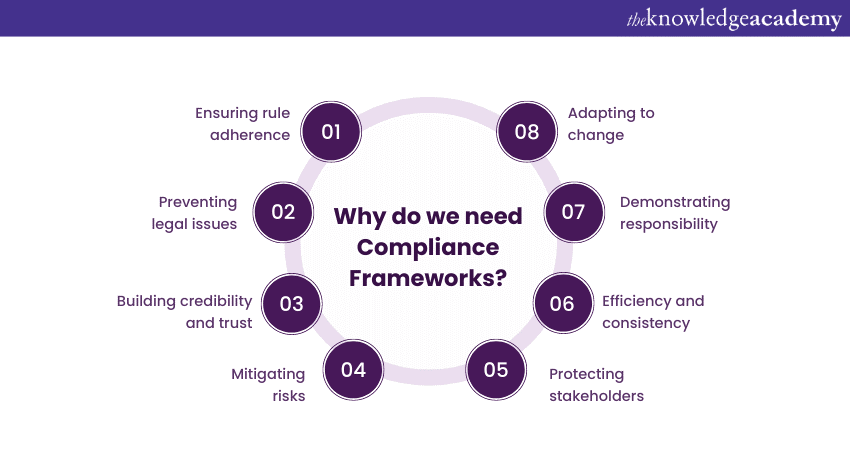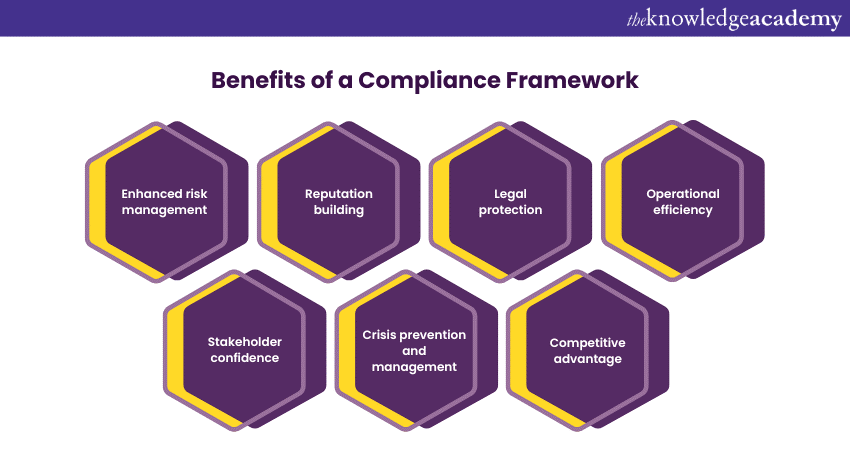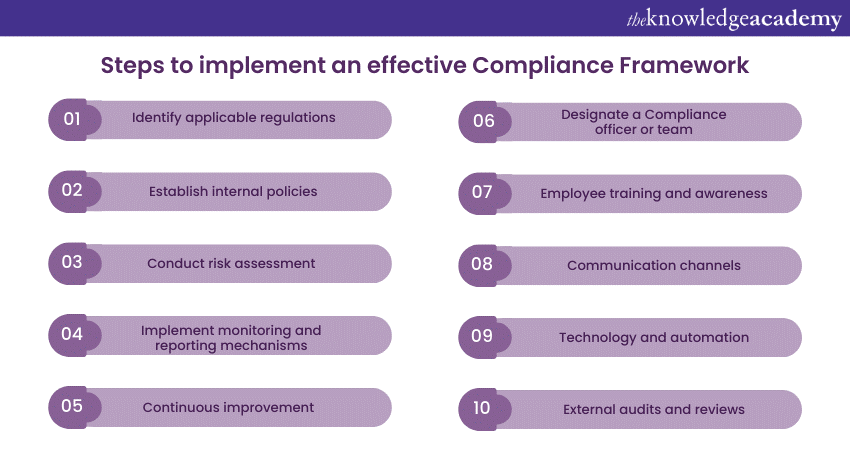We may not have the course you’re looking for. If you enquire or give us a call on 01344203999 and speak to our training experts, we may still be able to help with your training requirements.
Training Outcomes Within Your Budget!
We ensure quality, budget-alignment, and timely delivery by our expert instructors.

Have you ever thought about how companies make sure they're following all the rules that apply to them? The solution lies in a powerful tool known as a Compliance Framework. This framework is essential for businesses to stay on the right side of the law and operate responsibly. A well-designed Compliance Framework offers a systematic way to identify, assess, mitigate, and monitor Compliance risks.
However, if your organisation isn’t aware of this Framework, it’s time to get familiar with it and improve your credibility in the highly competitive market. So, what are you waiting for? Read this blog to learn everything about Compliance Framework that streamlines processes, ensures legal conformity, and reduces risks. Elevate your business standards today.
Table of Contents
1) What is Compliance?
2) Compliance Frameworks- An overview
3) Why do we need Compliance Frameworks?
4) Key components of a Compliance Framework
5) Benefits of a Compliance Framework
6) Steps to implement an effective Compliance Framework
7) Compliance Framework examples
8) Conclusion
What is Compliance?
Compliance is a multifaceted concept integral to organisations' proper functioning and ethical operation. It involves the systematic effort to align an entity's actions with established rules, regulations, standards, and ethical principles that govern its industry or operating environment.
This comprehensive approach extends beyond legal obligations. It encompasses various facets such as regulatory compliance, data protection compliance, and adherence to internal policies.
Effective Compliance Management involves not only the creation of policies but also their implementation and enforcement. This may include conducting regular audits, risk assessments, and employee training programs to promote a culture of compliance throughout the organisation.
Compliance Frameworks - An overview
A Compliance Framework is a structured system that organisations use to ensure they meet the rules and regulations that apply to their industry. It's like a set of guidelines that helps them stay on the right side of the law and operate ethically.
This Framework translates complex regulations into practical guidelines, fostering transparency, trust, and consistency in operations. By adhering to such a Framework, businesses not only mitigate risks and prevent legal issues but also contribute to their reputation as responsible and reliable entities in their community.
Why do we need Compliance Frameworks?
Just like people need rules to live together peacefully, businesses need rules to operate in a fair and lawful manner. Compliance Frameworks provide a clear roadmap for businesses to follow these rules and regulations. Still not sure why? Here's why your organisation needs a Compliance Framework:

Ensuring rule adherence
Compliance Frameworks are essential because they provide structured guidelines that ensure the business’ operations are within the boundaries set by laws and regulations. These Frameworks act as a rulebook, helping companies understand what they are allowed and not allowed to do.
Preventing legal issues
Just as individuals follow traffic rules to avoid accidents and penalties, businesses adhere to Compliance Frameworks to prevent legal complications. These Frameworks help businesses interpret complex regulations and implement practices that keep them in line with the law.
Building credibility and trust
Businesses that follow Compliance Frameworks demonstrate their commitment to ethical and lawful operations. This dedication to following rules builds credibility and trust among customers, partners, and stakeholders. It shows that the business is reliable and can be counted on.
Mitigating risks
Compliance Frameworks help identify potential risks and vulnerabilities within a business's operations. By addressing these risks early on, businesses can reduce the chances of financial losses, legal issues, and reputational damage.
Protecting stakeholders
Compliance Frameworks often include safety and security measures that protect employees, customers, and the public. By adhering to these measures, businesses ensure the well-being of all those who interact with their products or services.
Efficiency and consistency
Imagine a well-organised kitchen with all the ingredients neatly arranged. Compliance Frameworks bring a similar order to business operations. They establish consistent processes and procedures that lead to greater efficiency and smoother operations.
Demonstrating responsibility
Businesses are not just profit-making entities; they also have responsibilities towards society, the environment, and their employees. Compliance Frameworks help businesses fulfil these responsibilities by outlining practices that consider social, environmental, and ethical factors.
Adapting to change
Laws and regulations change over time, just as technology and customer expectations evolve. Compliance Frameworks enable businesses to stay updated with these changes, ensuring that they remain compliant despite shifting circumstances.
Master corporate governance principles with our Corporate Governance Training- join today!
Key Components of a Compliance Framework
A Compliance Framework consists of several key elements that work together to help organisations follow the rules and maintain ethical practices. These elements Include the following:
Regulatory requirements
The first important part of a Compliance Framework is understanding and sticking to the rules and regulations that apply to the industry a business is in. Just like how people follow traffic rules to stay safe on the road, businesses follow these rules to operate fairly, safely, and legally. This means learning and obeying the laws that tell businesses what they can and can't do, ensuring they act ethically and within legal boundaries.
Internal policies and procedures
Imagine a set of guidelines that everyone in a group follows to work together smoothly. That's what internal policies and procedures are for businesses.
These are rules that a company creates for itself to make sure everyone knows how to do their jobs correctly and ethically. These rules cover things like how to handle tasks, communicate, and make decisions within the business. It aligns the organisation’s actions with legal and ethical standards.
Risk assessment
Prior to embarking on a task, it is prudent to contemplate potential issues and make necessary preparations for them. Similarly, businesses must identify potential risks they might face. This process is called risk assessment.
It involves looking closely at their operations to spot areas where things could go wrong and cause harm, financial loss, or legal trouble. By identifying these risks early, businesses can take steps to prevent problems and protect themselves.
Monitoring and reporting
Businesses keep track of their actions and operations to ensure they're following rules and policies. Monitoring involves checking regularly to see if everything is going as planned.
If a mistake or problem is found, businesses report it to the right people, like a manager or authority. Reporting helps fix the issue and prevent it from becoming bigger. This constant checking and reporting ensure that businesses stay on the right track and are responsible and trusted by their stakeholders.
Join our comprehensive Compliance Training and navigate regulations with confidence!
Benefits of a Compliance Framework

Enhanced Risk Management
A well-structured Compliance Framework serves as a shield against potential risks. By systematically identifying and addressing Compliance vulnerabilities, businesses can proactively mitigate the likelihood of legal troubles, financial losses, and reputational damage. This proactive approach to Risk Management provides a solid foundation for sustainable growth and stability.
Reputation building
When organisations consistently follow regulations and ethical guidelines, they demonstrate their commitment to transparency, accountability, and responsible conduct. This fosters positive perceptions among customers, partners, investors, and the public, ultimately strengthening the organisation's reputation and brand equity.
Legal protection
Operating within the boundaries of a Compliance Framework shields businesses from legal pitfalls. Non-Compliance can lead to costly lawsuits, fines, and sanctions. However, a well-established Compliance Framework minimises such risks, ensuring that the organisation avoids legal entanglements and associated financial setbacks.
Operational efficiency
Compliance Frameworks streamline operations by providing clear guidelines. When employees understand the rules and how to adhere to them, processes become more efficient. These guidelines eliminate ambiguity, reduce errors, and save valuable time, contributing to smoother operations and improved productivity.
Stakeholder confidence
Transparency and ethical conduct engender trust among stakeholders. A strong Compliance Framework signals that the organisation is committed to integrity and accountability. This trust resonates with customers, investors, partners, and employees, fostering long-term relationships and bolstering the organisation's overall success.
Crisis prevention and management
In an ever-evolving regulatory landscape, Compliance Frameworks act as preventive measures against crisis situations. By being well-prepared and equipped with mechanisms to respond to unexpected challenges, organisations can manage crises effectively and minimise potential damages.
Competitive advantage
In a world where ethical practices and regulatory Compliance are highly valued, a strong Compliance Framework becomes a strategic asset. It differentiates the organisation from competitors and positions it as a trustworthy and responsible player in the market, attracting customers and partners who prioritise ethical partnerships.
Compliance Framework Examples
Compliance Frameworks are not one-size-fits-all solutions; they vary based on industries and the specific regulations they need to adhere to. Here are three diverse examples that highlight how Compliance Frameworks operate in different sectors:
Financial industry
In the financial sector, a Compliance Framework is paramount due to the intricate web of regulations designed to ensure stability and transparency. Institutions like banks and investment firms adhere to frameworks such as Basel III.
This framework sets guidelines for capital adequacy, risk assessment, and transparency. It ensures that financial institutions maintain sufficient capital reserves to weather economic downturns. Compliance in this context involves continuous monitoring of financial ratios, risk assessments, and reporting standards to maintain operational integrity.
Get equipped with Basel III essentials with our engaging Introduction To Basel III Course
Healthcare sector
Healthcare providers operate within a Compliance Framework to safeguard patient safety and privacy. A significant example is the Health Insurance Portability and Accountability Act (HIPAA) Compliance Framework in the United States. This framework mandates strict protocols for handling patient data, ensuring its confidentiality, integrity, and availability.
Healthcare entities must establish security measures, train staff, and implement procedures to protect patient information. This Compliance Framework not only prevents data breaches but also maintains patient trust and legal Compliance in a sensitive industry.
Data privacy regulations
The digital era has brought forth Compliance Frameworks to safeguard personal data. One prominent example is the General Data Protection Regulation (GDPR) in the European Union. GDPR mandates stringent rules for collecting, processing, and storing personal data, emphasizing individual privacy rights.
Businesses operating within the EU or handling EU citizens' data must ensure proper consent, data encryption, and the right to be forgotten. Compliance involves meticulous data management, transparent policies, and mechanisms for reporting breaches. This framework protects individuals' rights while encouraging responsible data-handling practices.
Steps to Implement an effective Compliance Framework
Implementing an effective Compliance Framework involves a systematic approach to ensure that an organisation adheres to regulations while maintaining ethical practices. Below are the recommended steps for implementing effective Compliance Framework:

Identify applicable regulations
The first step is to identify the specific laws, rules, and standards that apply to your organisation's industry and operations. This involves thorough research to understand the regulatory landscape. For instance, financial institutions need to identify regulations such as Anti-money Laundering (AML) and Know Your Customer (KYC) requirements. Understanding these regulations sets the foundation for your Compliance Framework.

Establish internal policies
Translate the identified regulations into practical internal policies and procedures. These policies should clearly explain how employees should behave and make decisions to comply with regulations and maintain ethical standards. For instance, if data protection regulations are applicable, your policies might outline how customer data should be collected, stored, and used securely.
Conduct risk assessment
Evaluate potential Compliance risks your organisation might face. Consider internal and external factors that could lead to non-Compliance or ethical breaches. This step helps you prioritise your efforts and allocate resources effectively.
For instance, if your business operates in an industry with strong rules about the environment, look at how your actions might affect nature. Then, figure out what you can do to lessen those risks.
Implement monitoring and reporting mechanisms
Set up systems to continuously monitor your organisation's activities and processes to ensure Compliance. This might involve regular audits, reviews, and checks to identify any deviations from established policies and regulations. If deviations are found, establish reporting mechanisms so that the right people are informed promptly, and corrective actions can be taken.
Continuous improvement
A Compliance Framework is not a one-time task; it requires ongoing commitment. Review regularly and update your policies and procedures to reflect changes in regulations and your organisation's operations. Seek feedback from employees, stakeholders, and experts to ensure that your framework remains effective and relevant.
Designate a Compliance officer or team
Appoint individuals or a team responsible for overseeing the Compliance Framework's implementation and maintenance. Their role involves staying updated with changing regulations, coordinating Compliance efforts across departments, and ensuring timely reporting and corrective actions.
Employee training and awareness
Educate employees about the Compliance Framework, its importance, and their roles in adhering to it. Regular training sessions can help employees understand regulations, internal policies, and the potential consequences of non-compliance. This boosts their awareness and responsibility towards maintaining Compliance.
Communication channels
Establish clear communication channels for employees to seek guidance, report concerns, or ask questions related to Compliance. An open communication environment encourages transparency and empowers employees to raise potential Compliance issues without fear of reprisals.
Technology and automation
Leverage technology to streamline Compliance processes. Implement software tools that automate monitoring, reporting, and data analysis. Automation reduces human error, provides real-time insights, and facilitates accurate record-keeping, contributing to an efficient Compliance Framework.
External audits and reviews
Consider engaging external experts or auditors to conduct periodic assessments of your Compliance Framework. Their independent perspective can uncover blind spots and provide valuable insights for improving your framework's effectiveness.
Compliance Framework examples
Compliance Frameworks are not one-size-fits-all solutions; they vary based on industries and the specific regulations they need to adhere to. Here are three diverse examples that highlight how Compliance Frameworks operate in different sectors:
Finance industry
In the financial sector, a Compliance Framework is paramount due to the intricate web of regulations designed to ensure stability and transparency. Institutions like banks and investment firms adhere to frameworks such as Basel III.
This framework sets guidelines for capital adequacy, risk assessment, and transparency. It ensures that financial institutions maintain sufficient capital reserves to weather economic downturns. Compliance in this context involves continuous monitoring of financial ratios, risk assessments, and reporting standards to maintain operational integrity.
Get equipped with Basel III essentials with our engaging Introduction To Basel III Course - join now!
Healthcare sector
Healthcare providers operate within a Compliance Framework to safeguard patient safety and privacy. A significant example is the Health Insurance Portability and Accountability Act (HIPAA) Compliance Framework in the United States. This Framework mandates strict protocols for handling patient data, ensuring its confidentiality, integrity, and availability.
Healthcare entities must establish security measures, train staff, and implement procedures to protect patient information. This Compliance Framework not only prevents data breaches but also maintains patient trust and legal Compliance in a sensitive industry.
Data privacy regulations
The digital era has brought forth Compliance Frameworks to safeguard personal data. One prominent example is the General Data Protection Regulation (GDPR) in the European Union. GDPR mandates stringent rules for collecting, processing, and storing personal data, emphasizing individual privacy rights.
Businesses operating within the EU or handling EU citizens' data must ensure proper consent, data encryption, and the right to be forgotten. Compliance involves meticulous data management, transparent policies, and mechanisms for reporting breaches. This Framework protects individuals' rights while encouraging responsible data-handling practices.
Conclusion
It is a world where rules and regulations must be followed. For that, a Compliance Framework is a crucial tool for organisations. It helps them follow the right path amidst complexities. Challenges like intricate regulations and evolving technology require constant attention. By working together, understanding the rules, and using resources wisely, organisations can stay on track.
Elevate your Compliance skills with our Effective Compliance Training, ensuring regulatory excellence.
Frequently Asked Questions

Establishing an effective Compliance Framework begins with a comprehensive understanding of industry-specific regulations. This entails conducting a thorough risk assessment to identify potential Compliance challenges unique to the business. Once risks are pinpointed, organisations can develop and implement precise policies and procedures to address these concerns. Regular internal audits are critical for monitoring adherence to the established Framework. Therefore, a Framework fosters a culture of compliance among employees through continuous training and effective communication adds an additional layer of robustness.

The periodic review of a Compliance Framework is crucial for its continued efficacy. While an annual review serves as a foundational check, the frequency should be adaptable to the dynamic nature of regulations and shifts in the business landscape. More frequent assessments become imperative when there are significant changes in regulatory requirements or alterations in the organisation's activities

Companies seeking tools and templates for creating a Compliance Framework tailored to their industry and specific needs have several options. Reputable industry associations often provide guidance and resources customised for different sectors. Consulting firms specialising in Compliance Management offer expertise and the ability to tailor frameworks to the organisation's unique requirements.<

The Knowledge Academy takes global learning to new heights, offering over 30,000 online courses across 490+ locations in 220 countries. This expansive reach ensures accessibility and convenience for learners worldwide.
Alongside our diverse Online Course Catalogue, encompassing 17 major categories, we go the extra mile by providing a plethora of free educational Online Resources like News updates, blogs, videos, webinars, and interview questions. Tailoring learning experiences further, professionals can maximise value with customisable Course Bundles of TKA.
The Knowledge Academy’s Knowledge Pass, a prepaid voucher, adds anoher layer of flexibility, allowing course bookings over a 12-month period. Join us on a journey where education knows no bounds.

The Knowledge Academy offers various Compliance Trainings, including Corporate Governance Course and Security Governance and Compliance Training. These courses cater to different skill levels, providing comprehensive insights into various Compliance Frameworks.
Our Compliance Training blogs covers a range of topics related to ISO and Compliance, offering valuable resources, best practices, and industry insights. Whether you are a beginner or looking to advance your Compliance skills, The Knowledge Academy's diverse courses and informative blogs have you covered.







 Top Rated Course
Top Rated Course



 If you wish to make any changes to your course, please
If you wish to make any changes to your course, please


